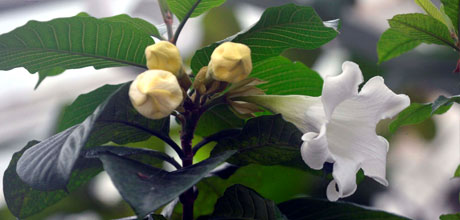High Climber Impresses
This article was first published on 23 Aug 2012.

Beaumontia
Next time you are visiting the winter garden glasshouse, looking at weird and wonderful plants, take the time to look up. It’s amazing how many people don’t. They miss out on seeing spectacular flower displays from climbers on display in the central house.
Currently flowering is Beaumontia grandiflora. Large white, scented, trumpet shaped flowers emerge from midwinter through to early spring, providing quite a show well above our heads, but easily missed if you don’t gaze skywards.
This climber, with attractive grey bark, twines up its supports, forming large woody stems. Leaves are large and glossy green, up to 25cm long and oblong to ovate in shape.
In the wild Beaumontia climbs impressively through trees and over rocks and shrubs. Native from India to Vietnam, it grows in the eastern foothills of the Himalayas at altitudes from 150m to 1400m.
Due to its large altitude range it will grow in a variety of climates. It does best with hot, moist summers and slightly cooler, drier autumn and winter temperatures which initiate flowering. These conditions are ideal for tropical or subtropical gardens. However, this climber will grow in more temperate areas and can even handle light frosts but may not flower well or at all if temperature’s not high enough.
Beaumontia do get attacked by a few common greenhouse pests. Mealy bug and thrips can become a problem if left unchecked but hard pruning after flowering will open up the plant, limiting sheltered areas that would provide opportunity for insects to happily feed and breed.
Stephen Bishop is curator of the winter garden glasshouse at Dunedin Botanic Garden.


